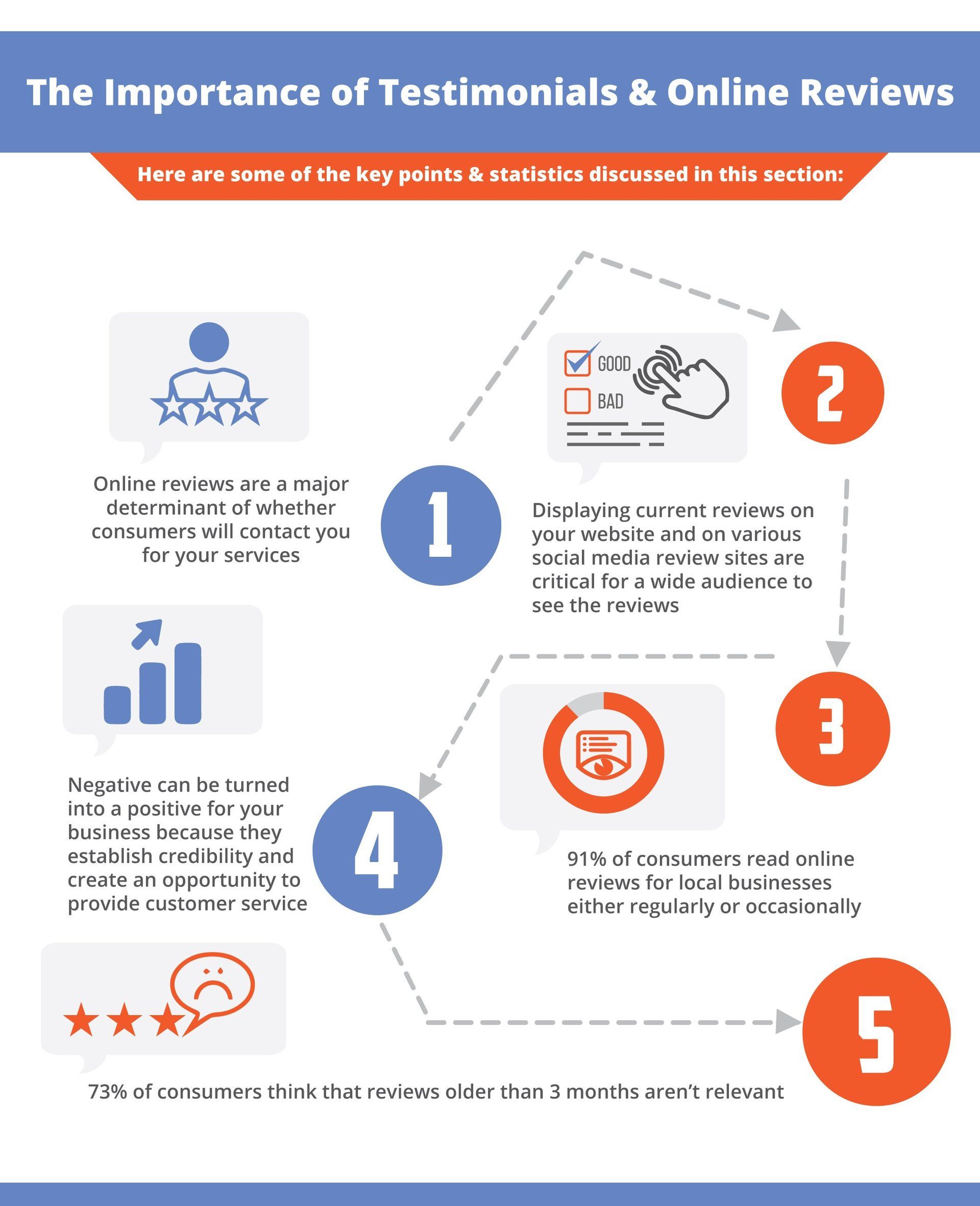Utilization of Testimonials and Reviews
Is Your Website Helping or Hurting Your Business? Pt. 2
Online reviews have been around a while. But in the past few years, they’ve increasingly become more important than ever, and the statistics to support its relevancy are overwhelming. Think about it: when you are considering buying a product on Amazon or searching for a restaurant to go to, do you ever look at the reviews to help make your decision? The answer, most likely, is yes.
Today, you can find just about anything online, whether that’s a product or a service, and everyone out there is in the business of marketing. Oftentimes, it’s hard to tell if the images and descriptions are really what you’re getting, or if you’re being scammed. But when we see online reviews from real people just like ourselves who are willing to testify for this brand, it gives us peace of mind that we’re making the right decision.
In a 2016 Local Consumer Review Survey conducted by BrightLocal, 91 percent of consumers read online reviews for local businesses either regularly or occasionally . This means that only 9 percent of consumers don’t read reviews at all. If you don’t have any online reviews, or if they aren’t properly displayed on your site (more on this in a minute), you could be losing out on 91 percent of potential customers who make their purchasing decisions based on online reviews of your business.
Mark Kresge, president of kitchen and bath remodeling company Kresge Contracting , said having testimonials shown on his site had a direct impact on attracting new, high-profile clients.
“When clients are signing paperwork to move forward with their remodeling project, they mention the reason they chose to work with us was because of our online reviews,” Kresge said.
Since Kresge Contracting started requesting and displaying reviews, it saw an increase in both the number of leads and overall project price. You can see why it is crucial to take advantage of satisfied customers and get them to leave you a review.
Displaying Reviews & Relevancy
Part of utilizing your online reviews is managing where those reviews are displayed. Reviews have become an important local ranking factor, as Google boosts companies with good online reputations over those with no reputation. Basically, if your company has a bunch of great reviews, you’re more likely to show up above your local competitor who has only a few online reviews.
Great reviews—and a lot of them—boost your business’s online credibility.
For those reviews to have merit with consumers, it’s important for them to be posted on various social media and review sites , where viewers can see who wrote the review and trust that it’s a legitimate post. Sites like Facebook, Yelp, Google and Houzz are some of the top places people look for reputable reviews.
Once you have a collection of positive reviews, you will want to display them on your own website, so visitors can view all your testimonials directly on your site. By utilizing an onsite testimonials section, you’ll be able to control which reviews show up on your website. For example, most successful businesses choose to only display 4- and 5-star reviews on their site.
Even positive reviews are no good if they are outdated. Just like the design of your website , it’s crucial that some of your reviews are current. In the same BrightLocal consumer survey mentioned above, 73 percent of consumers think that reviews older than 3 months aren’t relevant. This means that you need to constantly be asking customers for reviews if you want to appear as an up-to-date business. It’s great if you have hundreds of glowing reviews, but if they’re all from over a year ago, they won’t help your business.
Negative Reviews
Now, you may be wondering, what about negative reviews?
Most businesses hate negative reviews, and with good reason. You never want anyone making a complaint about less-than-stellar service from your business. But it is actually possible to utilize negative reviews and turn them into a positive for your business.
The first thing you want to do when you see a negative review about your business is respond. Start by apologizing about the experience, and offer a solution of some sort. If they weren’t happy with the service they received, do what you can to fix the issue. If there’s nothing you can do at this point, tell them you are working to fix the issue or offer an explanation as to why something happened the way it did, making sure you keep an understanding and respectful tone. Even if you are not able to change something, offering to make up for it goes a long way in customer service.
Negative reviews also allow you to find problems within your business and solve them. You may not have been aware of an issue that was brought to light by a customer. Whether you can learn from the review or not, you can still use it to your advantage by publicly responding, which will show consumers that even if they have a complaint, you are willing to go out of your way to make the customer happy.
The goal of publicly responding and offering a solution is to try to win them back as a customer, whether that means they will personally use your product or services again or recommend you to a friend. If you can get back into your customer’s good graces after a negative review, you’ve provided excellent customer service.
It’s also important to remember that having negative reviews make your business seem more credible. Of course, you don’t want a long series of bad reviews, but having a few mediocre reviews gives people peace of mind that all the reviews of your business are legitimate. When someone sees a company with all 5-star reviews, it can look suspicious, and leave the customer wondering if they’re being tricked.
The Bottom Line: No matter what your reviews say, if you provide good service, you can find a way to turn it into a positive thing for your business. Obviously, your business can start to suffer if you have an overwhelming amount of negative reviews. That’s why it’s important to reach out to customers yourself and ask for a review if they are satisfied (or ask them to reach out to you privately if they have an issue). By taking control of managing your online reviews, you’ll be a step ahead of the game.
This article is just one part of a larger series, “Is Your Website Helping or Hurting Your Business?” To read the article in its entirety and learn more about leveraging your website, click here .
Get the Latest Content in Your Inbox
Want to be the first to know about new content? Sign up to get our weekly blog posts sent to your email!








